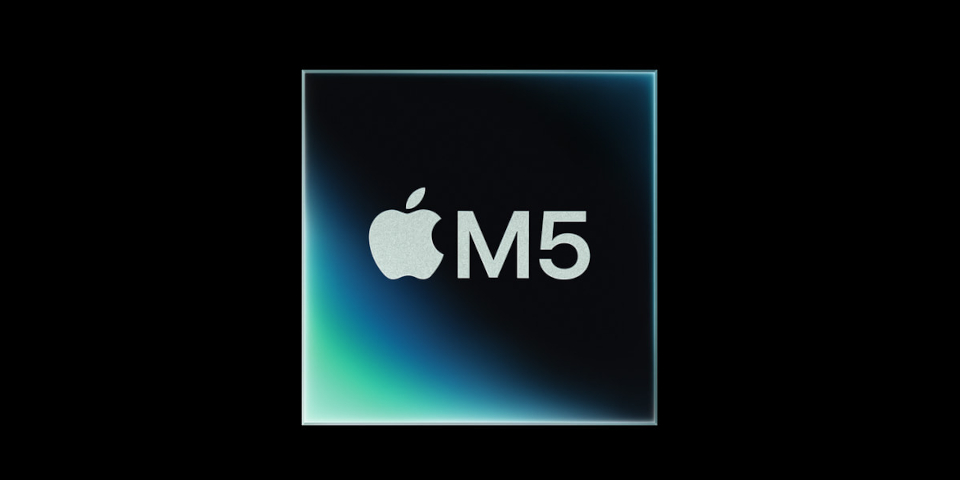Apple unveils its new M5 chip

Apple has unveiled the M5, the first chip in its fifth generation of Apple Silicon processors.
It “advances nearly every aspect” of the chip, particularly for GPU-based AI workloads, although Apple also claims significant improvements in hardware-accelerated ray tracing performance.
The base M5 processors are due to ship this month in new iPad Pros and MacBook Pros.
Below, we’ve summarized the M5’s key specs, and it performs relative to the previous-generation M4 processor in CG apps like Blender, DaVinci Resolve and Octane X.
| Apple Silicon processors | |||||
|---|---|---|---|---|---|
| M5 | M4 | M3 | M2 | M1 | |
| Process | 3nm | 3nm | 3nm | 5nm | 5nm |
| Unified memory (1,2) | 32 GB | 32 GB | 24 GB | 24 GB | 16 GB |
| Memory bandwidth | 153 GB/s | 120 GB/s | 100 GB/s | 100 GB/s | (68Gb/s) |
| CPU cores (1) | 10 | 10 | 8 | 8 | 8 |
| GPU cores (1) | 10 | 10 | 10 | 10 | 8 |
| GPU compute (1,3) (Teraflops) |
TBC | (4.3) | (3.5) | 3.6 | (2.6) |
| Hardware-accelerated ray tracing? | Yes | Yes | Yes | No | No |
| Neural Engine cores | 16 | 16 | 16 | 16 | 16 |
| AI performance (2) (TOPS) |
TBC | 38 | 18 | (16) | (11) |
| Video decode engines | 1 | 1 | 1 | 1 | 1 |
| Video encode engines | 1 | 1 | 1 | 1 | 1 |
| ProRes encode/decode engines | 1 | 1 | 1 | 1 | 0 |
| AV1 decode | Yes | Yes | Yes | No | No |
| Launch date | 2025 | 2024 | 2023 | 2022 | 2020 |
(1) Maximum configuration available
(2) Figures in brackets are from third-party websites
(3) GPU compute figures in brackets are taken from this research paper
Key specifications
On paper, the M5 processor is a smaller advance than previous generations, particularly the milestone M3 family of chips, which brought hardware-accelerated ray tracing to Macs.
Although the advance is more significant to the minimum configuration, which also gains processor cores, for the maximum configuration, the only key spec to change is memory bandwidth, which rises from 120 GB/s to 153 GB/s.
However, the M5 features a new architecture – a neural accelerator in each GPU core – and increased transistor density, which Apple claims results in more significant performance gains.
In a 14-inch MacBook Pro with 10 CPU cores and 10 GPU cores, Apple claims that the M5 delivers “15 percent faster multithreaded [CPU] performance” than the M4.
Graphics performance is “up to 30% faster”, and there is “up to a 45% graphics uplift in apps using ray tracing”, both measured using unspecified “industry-standard benchmarks”.
The biggest claimed change is to GPU-based AI workloads, where Apple claims the M5 provides “over 4x” the peak GPU compute performance of the M4.
Benchmark comparisons for CG software
So how do those specifications translate into real-world performance in CG software?
Although Apple’s announcement for the M5 itself doesn’t include any application-specific figures, there are some in the announcements for the new iPad Pro and MacBook Pro.
Comparing 13-inch iPad Pro systems with a 10-core CPU and 16 GB of unified memory, the M5 processor is:
Up to 1.2x faster than the M4 processor for video transcoding in Final Cut Pro
Up to 1.5x faster than the M4 processor for 3D rendering with ray tracing in Octane X
Up to 2.3x faster than the M4 processor for AI video upscaling in DaVinci Resolve
Comparing 14-inch MacBook Pro systems with 10 CPU cores, 10 GPU cores and 32 GB of unified memory, the M5 processor is:
Up to 1.7x faster than the M4 processor for 3D rendering with ray tracing in Blender
Up to 1.8x faster than the M4 processor for AI video enhancement in Topaz Video
There’s no information about how the iPad Pro systems were tested, but the figures for the MacBook Pro seem to have been obtained using the standard benchmarks.
The Topaz Video test was performed using Topaz Video 1.0 using the built-in benchmark, while the Blender test was performed with Blender 4.5, also using the “built-in benchmark”: presumably the Open Data benchmark.
M5 Pro and M5 Max still to come
As well as the base processor, all four previous generations of Apple Silicon processors have featured variants with more processor cores and unified memory.
Apple hasn’t confirmed the M5 Pro and M5 Max yet, but in the case of the M4 family, the M4 Pro and M4 Max were released four months after the base M4 processor.
Price and release date
M5 chips are due to ship in the new iPad Pros and MacBook Pros, currently available to pre-order, and due in stores on 22 October 2025.
Pricing for the new MacBook Pro starts at $1,499 for an 14-inch model with 10 CPU cores and 10 GPU cores, 16GB of unified memory, and 512GB SSD storage.
Read more about the M5 chip on Apple’s website
Have your say on this story by following CG Channel on Facebook, Instagram and X (formerly Twitter). As well as being able to comment on stories, followers of our social media accounts can see videos we don’t post on the site itself, including making-ofs for the latest VFX movies, animations, games cinematics and motion graphics projects.
